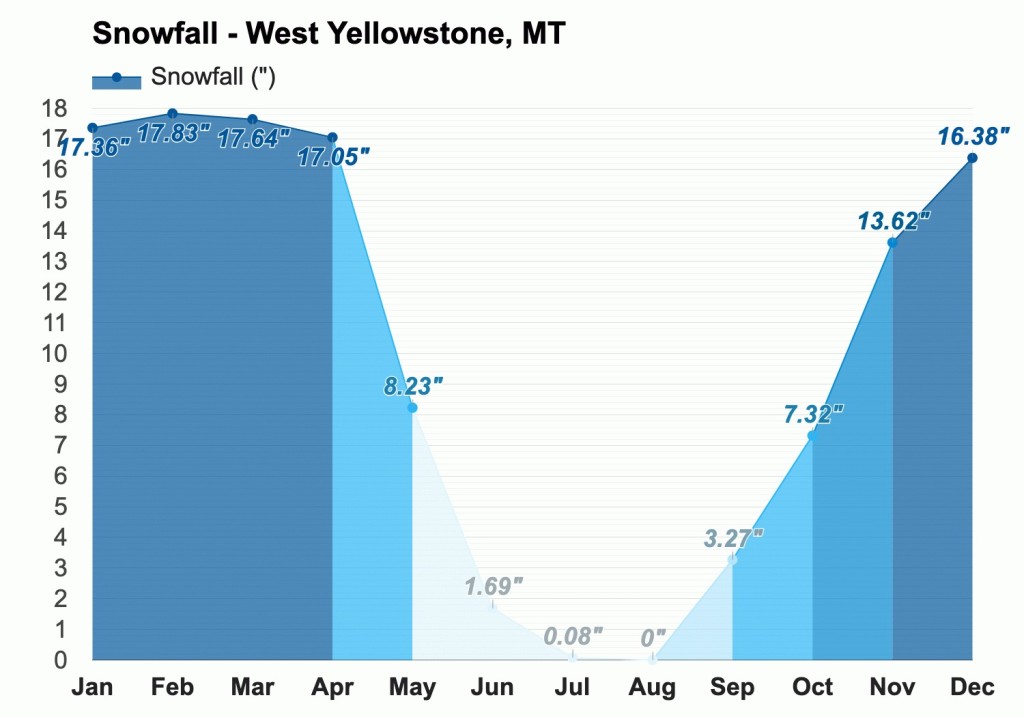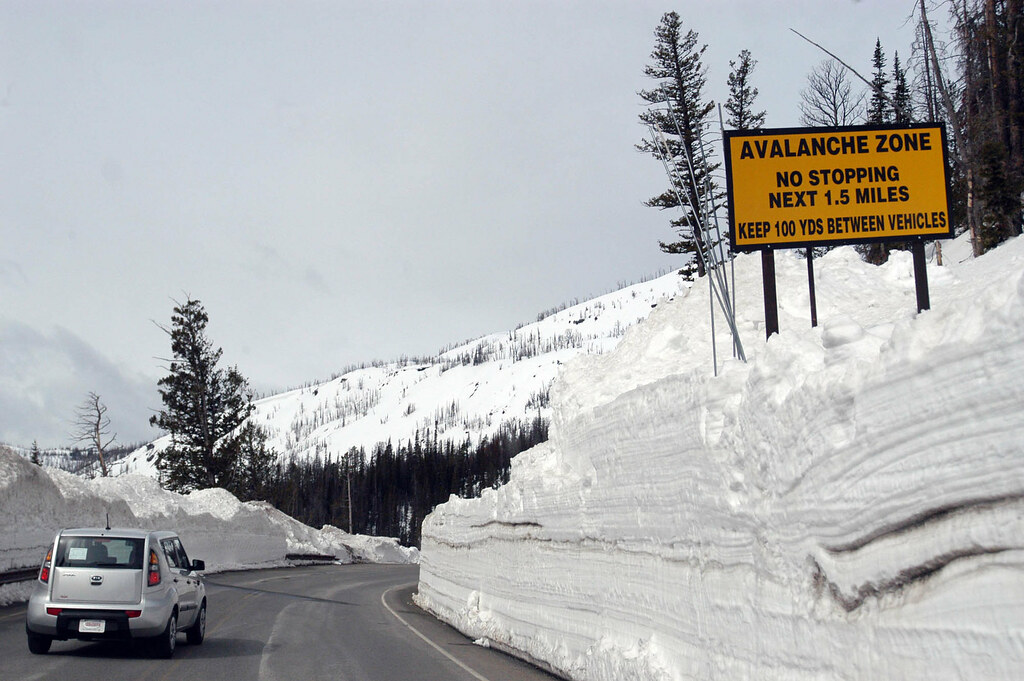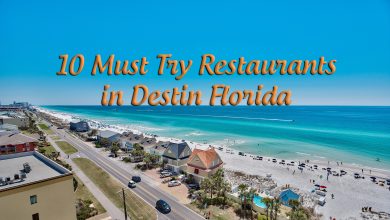
Millions of people go to Yellowstone every year, making it one of the busiest national parks in the United States. Yellowstone National Park spans the area of three states (Wyoming, Idaho, and Montana) covering over 2 million acres of breathtaking geological and geothermal phenomena. Many people go to Yellowstone to witness famous landmarks such as Mammoth Hot Springs, the Grand Canyon of Yellowstone, Old Faithful, and the Fishing Bridge.
Yellowstone National Park is a fantastic getaway for most of the year, but there are a few months out of the year that is considered the worst time to visit Yellowstone National Park. The park’s atmosphere and accessibility might be significantly altered by inclement weather.
The Worst Time to Go to Yellowstone National Park
The winter months, December to February, are the worst time to visit Yellowstone National Park, especially for the less daring tourists. The main reason is that temperatures drop far below freezing and the trails are blanketed in snow.

Due to the intense cold, animals follow their normal migratory patterns, and fewer paths are accessible for exploration, therefore fewer animals can be seen. Travelers should pack warm clothes and anticipate long delays due to road closures caused by bad weather if they plan to come during this period.
It also starts snowing early, towards the end of October on average, and the park’s sensitive ecosystems start to suffer from erosion caused by the freeze-thaw cycle. Because of the weather, going outside to take photos or explore is hazardous or impossible.
There will not be any working restrooms during the off-season, and there will only be a few ranger stations staffed. To some, it may seem like paradise; but, the cold here is unlike any other. Your “winter” coat will not keep you warm. Yellowstone National Park in northern Wyoming has harsh winters.
You will not be able to spend hours at a time hiking or touring outdoors. Looking out the vehicle window as you drive through Yellowstone will be one of your most memorable experiences there. The park will be closed and frozen over, and so will you.
Suggested Reading: Worst Time To Visit Costa Rica – Strictly Avoid
Advice for Tourists: Yellowstone in the Winters
Due to the snow and ice, several of the roads leading to the park are blocked. It is also more challenging to discover the wildlife that attracts tourists at this time of year. So, if you are thinking of visiting Yellowstone in the winter, here are some things to think about.

Dangerous Roads
When visiting Yellowstone in the winter, you must take all necessary safety measures. It is not uncommon for snow and avalanche hazards to block the roads going into the park, making getting there a risky proposition.

If you must drive yourself, invest in all-weather tires and any additional equipment, such as chains or tire studs that will improve your vehicle’s grip on ice roads. In case of an emergency, you should also let someone know your exact whereabouts and anticipated return time.
Pack Accordingly
It is no secret that Yellowstone’s winters can be frigid; in fact, it is not uncommon for the mercury to drop below freezing. It is crucial to pack warm clothing in layers, including sweaters, down coats, caps, and gloves, in case you find yourself in such a climate.
Also, if you can, get a pair of waterproof boots to protect your feet from the heavy snow drifts and puddles you can see on milder days when the snow melts. To be toasty and comfortable during your journey, it is recommended that you pack a thermos with some hot tea or chocolate.

The weather in Yellowstone during the winter may change rapidly. This is the time of year when snowstorms and blizzards are common, so it is important to know what to do if you get stranded in the wilderness. This includes knowing where shelter is located along your route in case you need it and having a plan for what to do if you get lost.
Follow the right rules and regulations as well. Earlier, the baby bison issue at Yellowstone National Park sparked a debate on social media. It’s better to follow the guidelines and don’t interact with park animals.
Carry Extra Food and Equipment
Restaurants are operating in the park throughout the winter, but if you plan on venturing far from civilization, there is a chance of unavailability or shortage of food. It is better to pack your provisions in case you end yourself in a region far from civilization with no means of obtaining food or water.
Bring along enough food and drink to satisfy everyone who will be accompanying you on your journey. Extra provisions, water, batteries, lighting, a means to make a fire, a first aid kit, a whistle in case of an emergency, a compass or GPS, a map, and a guidebook are just a few examples of useful equipment.

Suggested Reading: The BEST 7 Tennessee National Parks You Should Visit Today
Other Worst Times to Go to Yellowstone National Park
Other than the coldest months of the year, there are other seasons of the year that we consider the worst times to visit Yellowstone Park.
Early Spring
In March, the majority of the park’s services are unavailable. This month sees the change from winter accommodations to summer ones. The few lodges that are open throughout the winter close for a few months so that the roads can be plowed, and snowmobile traffic comes to a halt. Even in May, snowfall is common. Up to the first week of June, winter storms are still a possibility. Spring weather is often fickle, so it is best to be ready for everything.

The weather is also quite unpredictable, with fluctuating temperatures, occasional snowstorms, and muddy conditions due to snowmelt. Limited accessibility and reduced services may also be a factor.
Until late April, most park roads will remain blocked, and the park will be blanketed with snow. This is not the best time to come unless you plan on doing any winter sports like skiing or snowshoeing.
Opening months for most hotels are May and June. Staying in Gardiner or Cooke City outside the park and driving into the Mammoth or Lamar Valley regions is your only option if you want to visit in early to mid-April.
Editor’s Pick: Worst Time to Visit Disney World According To Experts
Rainstorms and Wildfires in Summer
Summers are another one of the worst times to visit Yellowstone because of abnormal weather. Storms are frequent and usually bring rain. Thunderstorms are common in the afternoon throughout the summer. Avoid the wet weather by beginning your explorations before daylight.
In addition to that, the wildfire season has been growing worse, unfortunately. Wildfires on the west coast (even as far west as California!) can have a significant impact on air quality and visibility, although this can vary widely from day to day. Notably, there have been several wildfires in this park in the past, which is why we recommend you avoid them.
| Year | Fire Name | Location | Size | Cause |
| 2003 | Cub Fire | Different parts of the park | 31,000 acres (125 sq km) | Lightning |
| 2003 | Falls Fire | Different parts of the park | 36,000 acres (146 sq km) | Lightning |
| 2008 | Buck Fire | The northwestern part of the park | 11,000 acres (45 sq km) | Lightning |
| 2016 | Maple Fire | The western portion of the park | 45,000 acres (182 sq km) | Lightning |
| 2020 | East Entrance Fire | Near the east entrance of the park | Small | Vehicle fire |
Most Crowded and Expensive Months to Visit Yellowstone
The peak season for tourists to Yellowstone National Park is summer. Since schools have holidays for the summer, families from Texas and Florida are flocking to the dry, cool climate of Wyoming, Montana, and Idaho.
Crowds at renowned destinations like Old Faithful tend to peak between the middle of June and Labor Day. The first month with over 1 million views was July 2021. Because of the tremendous demand, hotels are best reserved well in advance. If you wish to stay in the park during the summer, for instance, you need to make your reservations roughly a year in advance.

During summer, prices for cabin rentals in Yellowstone National Park become high from $89 per night to $300 per night, on average, depending on amenities and accessibility to the park. You can find simple, affordable rentals on Airbnb for roughly $100 per night, or you can get extremely nice, upmarket cabins for $500 per night and above.
In terms of months, June to August are some of the most expensive times to visit Yellowstone National Park.
Read Next: Splash into Summer: Louisiana’s Best Water Parks
When is the Worst Time to Visit Yellowstone National Park: According to Other Tourists?
Bilal Ahmed, our Senior Editor, visited Yellowstone during the peak season. According to him,”Visiting Yellowstone in the winter is like venturing into the middle of nothing. Nighttime lows are often in the negative or single digits. Normally, the whole trip is spent inside.”
Our Chief Editor, Umar Ali, said, “Yellowstone is stunning during peak season, but the crowds and long wait times at the park’s attractions make it difficult to enjoy the park’s natural grandeur, and also make it the worst time to visit Yellowstone National Park.”
Month-by-Month Analysis: Worst Months to Visit Yellowstone National Park
If you are still confused, you should follow our month-by-month guide to figure out the worst time to visit Yellowstone National Park and know about the best one as well.

January
- Average temperatures: Highs of 23°F (-5°C) and lows of 0°F (-18°C)
- Weather: Cold temperatures with frequent snowfall. Snow-covered landscapes create a picturesque winter wonderland.
- Activities: Cross-country skiing, snowshoeing, snowmobiling, and wildlife watching. Many trails and roads are closed, limiting access.
- Special events: Winter wildlife tours and educational programs.
- Crowd level: Relatively low, with fewer visitors compared to summer months.
February
- Average temperatures: Highs of 27°F (-3°C) and lows of 3°F (-16°C)
- Weather: Similar to January, with cold temperatures and snowfall. The park remains covered in snow.
- Activities: Winter sports, wildlife observation, and photography.
- Special events: Winter ecology programs and ranger-led snowshoe walks.
- Crowd level: Generally low, although there may be slightly more visitors during Presidents’ Day weekend.
March
- Average temperatures: Highs of 33°F (1°C) and lows of 12°F (-11°C)
- Weather: Transition period with melting snow, occasional snowstorms, and fluctuating temperatures. Signs of spring start to emerge.
- Activities: Wildlife watching, photography, and limited hiking on lower-elevation trails.
- Special events: Spring awakening programs and educational talks.
- Crowd level: Still relatively low, but it may start increasing towards the end of the month due to spring break holidays.
April
- Average temperatures: Highs of 43°F (6°C) and lows of 21°F (-6°C)
- Weather: Increasingly milder temperatures, with occasional snow and rain. Snowmelt leads to rising water levels in rivers and streams.
- Activities: Wildlife watching, birdwatching, limited hiking, and scenic drives.
- Special events: Earth Day celebrations and nature-focused workshops.
- Crowd level: Moderate, as more visitors begin to arrive in anticipation of spring and favorable weather conditions.
May
- Average temperatures: Highs of 55°F (13°C) and lows of 31°F (-1°C)
- Weather: Springtime temperatures continue to rise, but snowstorms are still possible. The park begins to awaken with blooming wildflowers.
- Activities: Wildlife watching, hiking, fishing, and photography.
- Special events: Memorial Day weekend festivities, photography workshops.
- Crowd level: Moderate to high, especially during the latter half of the month due to spring break holidays and the start of the summer season.
June
- Average temperatures: Highs of 69°F (21°C) and lows of 39°F (4°C)
- Weather: Pleasant temperatures with occasional rain showers. The park is lush and vibrant, with an abundance of wildflowers and active wildlife.
- Activities: Hiking, camping, fishing, wildlife viewing, and boating.
- Special events: Yellowstone Heritage and Research Center is open for the season, with ranger-led programs for visitors.
- Crowd level: High, as June marks the beginning of peak tourist season. Popular attractions and campgrounds may be crowded.
July (Most Crowded Month to Visit Yellowstone National Park)
- Average temperatures: Highs of 79°F (26°C) and lows of 45°F (7°C)
- Weather: Warm temperatures, occasional afternoon thunderstorms, and longer daylight hours. The park is at its busiest and most vibrant.
- Activities: Hiking, camping, fishing, wildlife viewing, boating, and swimming in select areas.
- Special events: Independence Day celebrations, guided wildlife tours, and evening ranger programs.
- Crowd level: Very high, as July is the peak tourist month. Expect crowded trails, congested parking areas, and limited campsite availability.
August
- Average temperatures: Highs of 78°F (26°C) and lows of 43°F (6°C)
- Weather: Similar to July, with warm temperatures and occasional thunderstorms. Wildflowers are in full bloom, and wildlife activity is abundant.
- Activities: Hiking, camping, fishing, wildlife watching, and photography.
- Special events: Yellowstone Heritage and Research Center presentations, geology walks.
- Crowd level: High, but slightly less crowded compared to July due to some families returning to school. Popular areas can still be crowded.
September (Best Month to Visit Yellowstone National Park)
- Average temperatures: Highs of 67°F (19°C) and lows of 34°F (1°C)
- Weather: Cooler temperatures, changing foliage colors, and increased chance of snow at higher elevations. Fall is a stunning time to visit.
- Activities: Hiking, wildlife watching, fishing, and photography.
- Special events: Autumn nature walks, ranger-led talks on wildlife migration.
- Crowd level: Moderate to high at the beginning of the month, but starts to decrease towards the end as summer crowds dwindle.
October
- Average temperatures: Highs of 52°F (11°C) and lows of 25°F (-4°C)
- Weather: Cool temperatures, potential for snowfall, and a beautiful display of fall colors. The park becomes quieter and more serene.
- Activities: Wildlife viewing, photography, and hiking on lower-elevation trails.
- Special events: Fall photography workshops and guided nature hikes.
- Crowd level: Moderate, with fewer visitors compared to summer months. Some facilities and services may start closing for the season.
November
- Average temperatures: Highs of 35°F (2°C) and lows of 15°F (-9°C)
- Weather: Cold temperatures, occasional snowfall, and limited access to certain areas due to road closures. The park prepares for winter.
- Activities: Wildlife watching, photography, and snowshoeing in select areas.
- Special events: Thanksgiving programs and educational talks.
- Crowd level: Relatively low, as visitor numbers decline with the onset of winter conditions and reduced services.
December (Worst Time to Visit Yellowstone National Park)
- Average temperatures: Highs of 25°F (-4°C) and lows of 6°F (-14°C)
- Weather: Cold temperatures, frequent snowfall, and limited accessibility due to road closures. The park is covered in a pristine blanket of snow.
- Activities: Cross-country skiing, snowshoeing, wildlife observation, and photography.
- Special events: Winter solstice celebrations and snow science workshops.
- Crowd level: Low, with very few visitors. Many facilities and roads are closed, limiting access to certain areas.
Check out more of our “When to Visit” guides for other destinations!
Conclusion
Yellowstone National Park is truly one of the most beautiful parks in the US. To ensure you make the most of your visit, it is essential to familiarize yourself with the park’s diverse offerings, seasonal variations, and helpful tips along with the times you should avoid visiting Yellowstone National Park. We highly recommend looking through our comprehensive guide before embarking on your Yellowstone adventure. It will provide valuable insights and practical advice to enhance your experience in this extraordinary national park.
Worst Time to Visit Yellowstone - FAQs
Winter months, particularly January and February, can be challenging due to heavy snowfall, limited accessibility, and reduced services. Spring months, such as March and April, can be unpredictable with changing weather conditions. It’s essential to check for road closures and plan accordingly during these times.
Fall, particularly September, and October, can be a fantastic time to visit Yellowstone. The park showcases stunning autumn colors, fewer crowds, and wildlife sightings, as animals prepare for winter.
Yellowstone National Park can get quite crowded during the peak summer season, especially in July and August. Popular attractions and areas near visitor centers can experience significant crowds.





